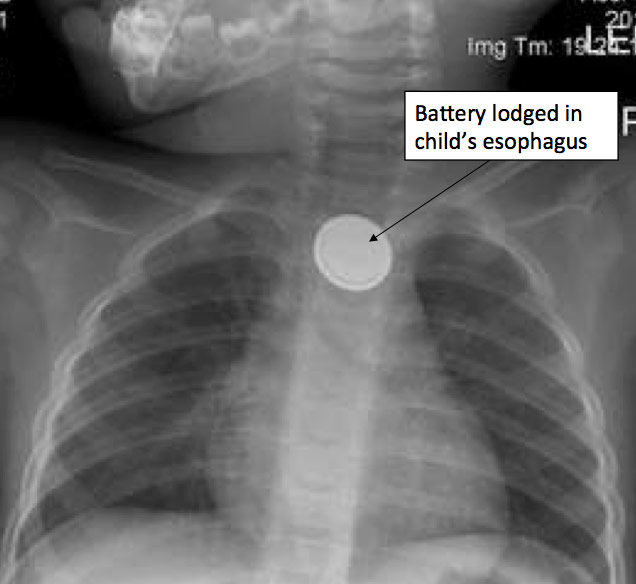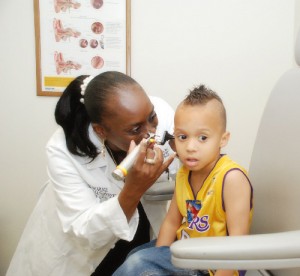- New Sublingual Allergy Tablets - October 31, 2014
- Ground-breaking New Treatment Option for Sleep Apnea - September 27, 2014
- Allergies versus Viruses in Children - September 27, 2014
- “Dog Dust” Protects Children from Allergies - September 27, 2014
- Nasal Saline Irrigation - August 8, 2014
- Doctor, I am Allergic to Dust. What Can I do? - July 31, 2014
- Infants Exposed to Dust Mites Less Likely to Develop Allergies - June 23, 2014
- How to Treat a Young Child’s Cough - December 17, 2013
- Many Parents are Unaware That Their Children Are at Risk for Noise Induced Hearing Loss - December 9, 2013
- Is it a Cold or an Ear Infection? - December 9, 2013
It is hard to imagine that something as simple as the battery for an electronic device can lead to the injury or death of a child. Such stories are reported occasionally, and bring to light the potentially devastating consequences of a child swallowing a battery. Because batteries for devices are getting smaller and the devices themselves are more common, the incidence of injury or death from a child swallowing a battery is increasing. Parents should be aware of the signs and symptoms to look out for so they are able to bring their child to urgent attention before it is too late.
What is a button battery?
A button battery is a small battery, usually the size of a nickel or smaller. They are commonly found in small electronic devices, such as remote controls, timers, cameras, watches, and scales. As devices get smaller, so do the batteries that power them, making these button batteries far more common than they used to be. Their small size makes them all the more likely to be put in a child’s mouth.
How do I know if my child has swallowed a battery?

Unless you see your child put the battery in his mouth, there is no way to be completely sure he/she has swallowed a battery unless an x-ray is performed. Symptoms are vague and not specific, which may make a parent wait to bring their child to medical attention. Indeed, in one case the diagnosis was delayed because the child simply appeared to be teething. However, a parent may be suspicious if they see the following symptoms:
- Fever
- Cough
- Difficulty swallowing
- Drooling
- Vomiting
- Sore throat
- Belly or chest pain
- Wheezing, noisy breathing
- Eating/drinking less
This list demonstrates how many symptoms of battery ingestion overlap with symptoms of a common cold or GI illness. The parent needs to be alert for behavioral changes in their child and if anything is suspected, bring the child in for evaluation to an emergency room or pediatric ENT.
How does the battery injure the child?
Batteries cause injury when they are stuck in the esophagus (swallowing passageway). When the battery becomes stuck in the esophagus, it begins to generate a current. This current damages the tissue of the esophagus and results in death of the tissue. In as short as 6 hours, the tissue can develop a complete hole, called a perforation, which can result in death. If a hole does not develop, the child will still suffer from injury due to tissue death, similar to a burn injury. Injury can occur even with a “dead” battery as any small amount of remaining voltage can be conducted by adjacent tissue.
Even after removal, tissue death and injury continue to occur because of leftover battery material and weakened tissues of the esophagus. Critical observation is required during this time.
How is battery ingestion treated?
Prevention is the most important step. The technology industry is making changes to secure the battery compartment and safer battery technology is being designed. However, as the mother of two small boys, I have been amazed how often my son has brought me the battery separate from his toy, with the screw locked cover still intact. What can you do as a parent?
Educate yourself, other care givers and your children. Keep batteries contained in a secure location out of reach of children. Button batteries especially should be left in the manufacturer packing. Tell your children batteries are DANGEROUS and they should never be played with.
Prompt evaluation and surgical intervention are required to reduce the risk of severe consequences from button battery ingestion.
What else should I know about these small batteries?
It is important to recognize that a child may also be tempted to put batteries in their nose or ears, especially smaller batteries such as hearing aid batteries. While these usually cause less dramatic problems, they still need immediate attention. In the ear, batteries can cause ear drum perforation, hearing loss or facial nerve paralysis. In the nose, the batteries can erode the tissue resulting in nasal collapse and scarring.
If you think your child has swallowed or placed a battery in his ear or nose, it necessitates an immediate ER evaluation with consultation of a pediatric otolaryngologist.
Additional resources:
1. Jatana KR, Litovitz T, Reilly JS, Koltai PJ, Rider G, Jacobs IN. Pediatric button battery injuries: 2013 task force update. Int J Pediatr Otorhinolaryngol. 2013 September 2013:77(9):1392-99.
2. T. Litovitz, N. Whitaker, L. Clark. Preventing battery ingestions: an analysis of 8648 cases. Pediatrics, 125 (6) (2010), pp. 1178–1183



